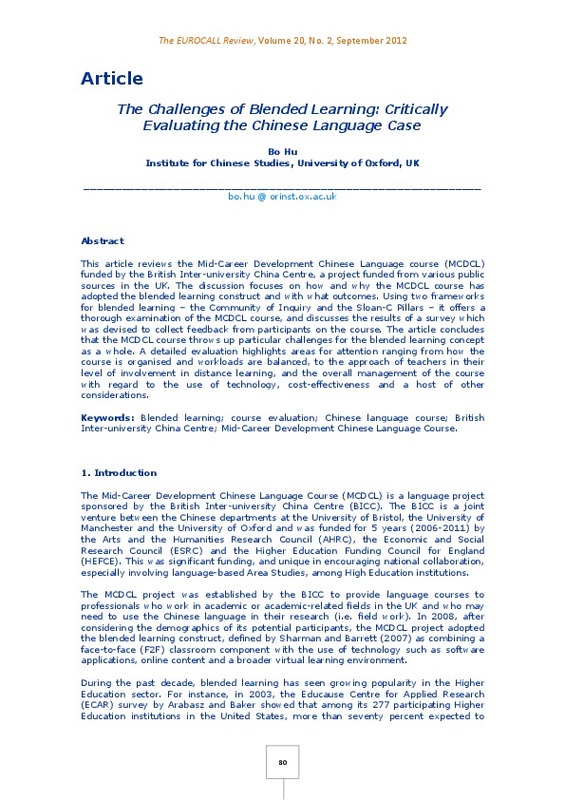Arabasz, P. and Baker, B., M. (2003). Supporting e-learning in higher education. Educause Centre for Applied Research. Avalialable from http://www.educause.edu/ECAR/SupportingELearninginHigherEdu/156516 (Last accessed on March 21, 2011).
Anderson, T., Rourke, L., Garrison, D.R. and Archer, W (2001). Assessing teaching presence in a computer conferencing context. Journal of Asynchronous Learning Networks, 5(2). Available from http://auspace.athabascau.ca/handle/2149/725 (Last accessed on December 15, 2011)
Benbunan-Fich, R. and Hiltz, R. S. (1999). Impacts of asynchronous learning networks on individual and group problem solving: A field experiment. Group Decision and Negotiation, 8, pp. 409-426. https://doi.org/10.1023/A:1008669710763
[+]
Arabasz, P. and Baker, B., M. (2003). Supporting e-learning in higher education. Educause Centre for Applied Research. Avalialable from http://www.educause.edu/ECAR/SupportingELearninginHigherEdu/156516 (Last accessed on March 21, 2011).
Anderson, T., Rourke, L., Garrison, D.R. and Archer, W (2001). Assessing teaching presence in a computer conferencing context. Journal of Asynchronous Learning Networks, 5(2). Available from http://auspace.athabascau.ca/handle/2149/725 (Last accessed on December 15, 2011)
Benbunan-Fich, R. and Hiltz, R. S. (1999). Impacts of asynchronous learning networks on individual and group problem solving: A field experiment. Group Decision and Negotiation, 8, pp. 409-426. https://doi.org/10.1023/A:1008669710763
Benson, P. (2001). Autonomy in Language Learning. Pearson Education Limited. Blended Learning Unit. Available from http://www.herts.ac.uk/about-us/learning-and- teaching/learning-teaching-institute/blu-cetl/home.cfm (Last accessed on March 21, 2011).
Broady, E. and Kenning, M. (1996) Promoting Learner Autonomy in University Language Teaching. London: CiLT.
British Inter-university China Centre. http://www.bicc.ac.uk/ (Last accessed on March 21, 2011)
Garrison, R. D. and Anderson, T. (2003). E-learning In the 21st Century: A framework for research and practice. London: Routledge https://doi.org/10.4324/9780203166093
Garrison, R. D., Anderson, T., and Archer, W. (2000). Critical inquiry in a text-based environment: Computer conferencing in higher education. The Internet and Higher Education, 2(2-3): 87-105. https://doi.org/10.1016/S1096-7516(00)00016-6
Garrison, R. D., Anderson, T. and Archer, W. (2001). Critical thinking and computer conferencing: A model and tool to assess cognitive presence. American Journal of Distance Education, 15(1): 7-23. https://doi.org/10.1080/08923640109527071
Garrison, R. D. and Arbaugh, J. B. (2007). Researching the community of inquiry framework: Review, issues, and future directions. Internet and Higher Education, 10(3): 157-172. https://doi.org/10.1016/j.iheduc.2007.04.001
Garrison, R., D. and Vaughan, D., N (2008). Blended Learning in Higher Education: Framework, Principles, and Guidelines. San Francisco, CA: John Wiley & Sons, Inc.
Graham (2006). Blended learning systems: definition, current trends, and future directions. In Bonk, C. and Graham, C. (Eds), The Handbook of Blended Learning: Global Perspectives, Local Designs. San Francisco, CA: Pfeiffer Publishing, pp. 3-21.
Graham, C. R., Allen, S., and Ure, D. (2005) Benefits and challenges of blended learning environments. In M. Khosrow-Pour (Ed.), Encyclopedia of information science and technology. Hershey, PA: Idea Group, pp. 253-259. https://doi.org/10.4018/978-1-59140-553-5.ch047
Hanson, K. & Clem, F. (2006). To blend or not to blend: A look at community development via blended learning strategies. In Bonk, C. and Graham, C. (Eds), The Handbook of Blended learning: Global Perspectives, Local Designs. San Francisco, CA: Pfeiffer Publishing, pp. 136-154.
Hong, H. K. and Samimy, K. K. (2010). The influence of L2 teachers' use of CALL modes on language learners' reactions to blended learning. CALICO Journal, 27(2): 328-348. https://doi.org/10.11139/cj.27.2.328-348
Hu, B. (2010). The challenges of Chinese: a preliminary study of UK learners' perceptions of difficulty. Language Learning Journal, 38(1): 99-118. https://doi.org/10.1080/09571731003620721
Kvavik, B. R. and Caruso, B. J. (2005). ECAR Study of Students and Information Technology, 2005: Convenience, Connection, Control, and Learning. Educause Centre for Applied Research. Available from http://net.educause.edu/ir/library/pdf/ers0506/rs/ERS0506w.pdf (Last accessed on March 21, 2011).
Laumakis, M., Graham, C. and Dziuban, C. (2009). The Sloan-C pillars and boundary objects as a framework for evaluating blended learning. Journal of Asynchronous Learning Networks, 13(1): 75-87.
Lorenzo, G. and Moore, G. L. (2002). The Sloan Consortium Report to the Nation: Five Pillars of Quality Online Education. The Sloan Consortium. Available from http://sloanconsortium.org/publications/books/pillarreport1.pdf (Last accessed on March 21, 2011).
McPherson, M. and Nunes, M., B. (2004). The failure of a virtual social space (VSS) designed to create a learning community: Lesson learned. British Journal of Educational Technology, 35(3): 305-321. https://doi.org/10.1111/j.0007-1013.2004.00391.x
Moore, C.J. (2005) The Sloan Consortium Quality Framework and The Five Pillars. The Sloan Consortium. Available from http://sloanconsortium.org/publications/books/qualityframework.pdf (Last accessed on March 21, 2011).
Neumeier, P. (2005). A closer look at blended learning. Parameters for designing a blended learning environment for language teaching and learning. ReCALL, 17(2), 163-178. https://doi.org/10.1017/S0958344005000224
Newman, D. R., Webb. B. and Cochrane, C. (1997). Evaluating the quality of learning in computer supported cooperative learning. Journal of the American Society for Information Science, 48(6): 484-495. https://doi.org/10.1002/(SICI)1097-4571(199706)48:6<484::AID-ASI2>3.0.CO;2-Q
Osguthorpe, T. and Graham, C. (2003). Blended learning environments: definitions and directions. Quarterly Review of Distance Education, 4(3): 227-233.
Sharman, P. and Barrett, B. (2007). Blended Learning: Using technology in and beyond the language classroom. Oxford: Macmillan.
Shea, P., Hayes, S., Gozza-Cohen, M., Uzuner, S., Mehta, R., Valchova, A. and Rangan, P. (2010). A re-examination of the community of inquiry framework: Social network and content analysis. Internet and Higher Education, 13(1-2), 10-21. https://doi.org/10.1016/j.iheduc.2009.11.002
Salaway, G., Caruso, B. J. and Nelson, R. M. (2008). The ECAR Study of Undergraduate students and Technology Information. Educause Centre Applied Research. Available from http://www.educause.edu/ECAR/TheECARStudyofUndergraduateStu/163283 (Last accessed on March 21, 2011).
So, H. and Brush, T. (2008). Student perceptions of collaborative learning, social presence and satisfaction in a blended learning environment: Relationships and critical factors. Computers & Education, 51(1): 318-336. https://doi.org/10.1016/j.compedu.2007.05.009
Williams, E., Duray, R. and Reddy, V. (2006). Teamwork orientation, group cohesiveness, and student learning: A study of the use of teams in online distance education. Journal of Management Education, 30(4) 592-616. https://doi.org/10.1177/1052562905276740
Zhao, Y. and Lai, C. (2008). Massively Multi-Player Online Role Playing Games (MMORPGS) and Foreign Language Education. In Ferdig, R. (Ed.) Handbook of Research on Effective Electronic Gaming in Education. New York: IDEA Group.
[-]







![HTML file [HTML]](/themes/UPV/images/html.png)

